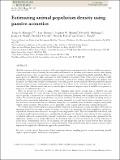Estimating animal population density using passive acoustics
Abstract
Reliable estimation of the size or density of wild animal populations is very important for effective wildlife management, conservation and ecology. Currently, the most widely used methods for obtaining such estimates involve either sighting animals from transect lines or some form of capture-recapture on marked or uniquely identifiable individuals. However, many species are difficult to sight, and cannot be easily marked or recaptured. Some of these species produce readily identifiable sounds, providing an opportunity to use passive acoustic data to estimate animal density. In addition, even for species for which other visually based methods are feasible, passive acoustic methods offer the potential for greater detection ranges in some environments (e.g. underwater or in dense forest), and hence potentially better precision. Automated data collection means that surveys can take place at times and in places where it would be too expensive or dangerous to send human observers. Here, we present an overview of animal density estimation using passive acoustic data, a relatively new and fast-developing field. We review the types of data and methodological approaches currently available to researchers and we provide a framework for acoustics-based density estimation, illustrated with examples from real-world case studies. We mention moving sensor platforms (e.g. towed acoustics), but then focus on methods involving sensors at fixed locations, particularly hydrophones to survey marine mammals, as acoustic-based density estimation research to date has been concentrated in this area. Primary among these are methods based on distance sampling and spatially explicit capture-recapture. The methods are also applicable to other aquatic and terrestrial sound-producing taxa. We conclude that, despite being in its infancy, density estimation based on passive acoustic data likely will become an important method for surveying a number of diverse taxa, such as sea mammals, fish, birds, amphibians, and insects, especially in situations where inferences are required over long periods of time. There is considerable work ahead, with several potentially fruitful research areas, including the development of (i) hardware and software for data acquisition, (ii) efficient, calibrated, automated detection and classification systems, and (iii) statistical approaches optimized for this application. Further, survey design will need to be developed, and research is needed on the acoustic behaviour of target species. Fundamental research on vocalization rates and group sizes, and the relation between these and other factors such as season or behaviour state, is critical. Evaluation of the methods under known density scenarios will be important for empirically validating the approaches presented here
Citation
Marques , T A , Thomas , L , Martin , S , Mellinger , D , Ward , J , Moretti , D , Harris , D V & Tyack , P L 2013 , ' Estimating animal population density using passive acoustics ' , Biological Reviews of the Cambridge Philosophical Society , vol. 88 , no. 2 , pp. 287–309 . https://doi.org/10.1111/brv.12001
Publication
Biological Reviews of the Cambridge Philosophical Society
Status
Peer reviewed
ISSN
1464-7931Type
Journal article
Collections
Items in the St Andrews Research Repository are protected by copyright, with all rights reserved, unless otherwise indicated.

